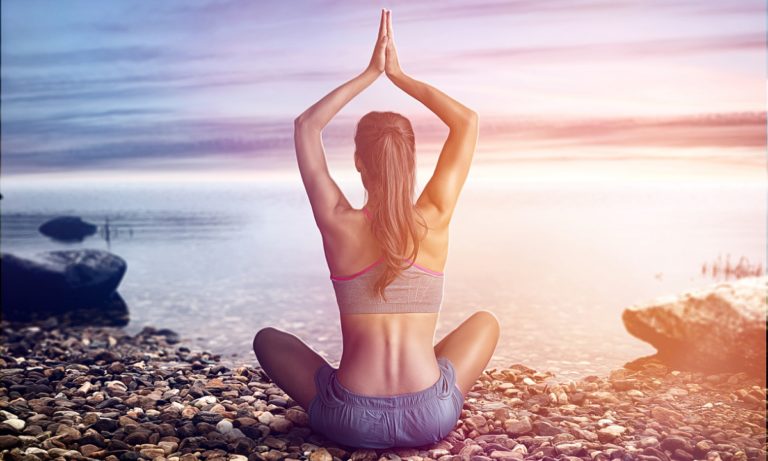Striking the Perfect Balance Between Sweating in Hot Yoga and Hydrating
Hot yoga has become the favorite type of yoga for thousands of people. Every year, more and more people venture into one of those hot studios for the first time and experience something they haven’t before.
While this number greatly varies, the average person loses around four to eight pounds of water-weight. That means anywhere between half a gallon to a full gallon of sweat ends up on your yoga mat and hot yoga towel. While it might be cool to flaunt the sheer amount of weight you dropped in one class, and it is impressive so give yourself a pat on the back, there has to be some balance to avoid dehydration.
What are the Risks of Dehydration?

Dehydration, by definition, is when your body loses more fluid than it takes in below a healthy equilibrium. We lose water all day through everything such as the water vapor as we exhale to urination, and if we’re not drinking water we could suffer from a multitude of nasty symptoms. Symptoms of dehydration include:
- Dry mouth, swollen tongue, increased thirst.
- Weakness, dizziness, and confusion.
- Heart palpitations.
- Sluggish demeanor.
- Fainting.
- Inability to sweat.
As long as you are regularly drinking water all day, dehydration isn’t likely to occur. But after any strenuous activity that involves a lot of sweating such as hot yoga, your body gets placed in a more risky state. As you can imagine, losing a gallon of water in the period of an hour without any additional liquid is an easy way to put yourself in the danger zone without further attention.
Simply put, water is the lubricant that helps your brain and body work efficiently. It’s a critical part of many of the chemical reactions in the body, and if those reactions slow down, everything from muscle repair to tissue healing becomes slower.
When you sweat, your body not only loses water, it also loses electrolytes. These charged molecules help conduct electricity in the body and are very important in transmitting signals. They do a wide assortment of things such as regulating muscle contraction, heart rate, balancing body fluids, and controlling your pH levels. They affect virtually every organ in the body, and without them your body cannot function properly.
Hot Yoga: Sweating is Inevitable
Some people sweat a lot, some people sweat a little, but the bottom line is everybody will sweat. The sweating in hot yoga is a steep decline.
You start out walking into the room and acclimating your body with the temperature. Perhaps your instructor has you lay down on your back and spread awareness to your arms and legs. You feel your body slowly warming up. Next, your instructor has you hold a downward dog pose. You start to see small droplets of sweat start forming on your forearm, perhaps a bead of sweat hits the mat. Fast-forward a few more minutes and a few more poses and suddenly you’re drenched in sweat and your yoga towel is doing its best to soak up the litres of water dropping from your body.
Sweating is personally one of my favorite things about hot yoga, but I am always wary of dehydration. This is why I always make the effort to be properly hydrated all day before my class and to have an extra glass or two of water and some gatorade once I finish.
Early morning yoga classes put you at an even higher risk of dehydration since you’ve just gone through an 8 hour period without additional liquid.
Striking the Perfect Balance
Most people know they should be drinking plenty of water all day, and it’s fairly uncommon for someone to willingly not drink water during and after a hot yoga session. What’s dangerous for many people is that it’s easy to forget, since hot yoga puts you in a very calm and relaxed state. Instead of acting on your body’s alerts that you need water, you might wave them off in your blissful complacency without even knowing it.
That’s why striking the perfect balance requires an active effort. Here are a few ways that will ensure that you are properly hydrated without making too big of a cognitive effort to remember.
- Drink up all day. You don’t need to drown yourself in water before a class, but just make sure you are properly hydrated. When you’ve actually got a lot of water in you, your body will use it for more sweat. This sweat not only acts as a natural coolant for your body, but it also helps rid your body of toxins and purify itself.
- Bring a sealed bottle with you. It’s not uncommon for people in hot yoga to have a bottle or canteen of water with them in the room. The lovely thing about yoga is that it pushes you to go at your own pace, and allows for breaks at any time. Just be sure to bring one that can be sealed after opened to avoid causing chaos if you accidentally tip it over.
- Reward yourself after yoga. There’s nothing like a nice cold Gatorade or bottle of water right after finishing a strenuous workout.

What to Drink:
Since hot yoga causes people to sweat so much, water alone isn’t going to get you properly hydrated. You need something that can help you replace the lost electrolytes. The essential electrolytes your body needs include sodium, potassium, magnesium, chloride, phosphate, sulphate, calcium ions, and bi-carbonates.
The most common way to get electrolytes are with sports drinks such as Gatorade, but those have a lot of sodium and sugar. If you’re in a situation where the following substitutes are not available, a sports drink will serve you just fine.
One of my favorites for hydration is coconut water. It’s one of the perfect sources of electrolytes, and it’s also natural. Try to find coconut water that is not from a concentrate. Emergen-C is also a great source of electrolytes.
Final Thoughts
Hot yoga and hydration go together in perfect harmony. By making sure we are drinking enough water and getting enough electrolytes post exercise, we can reap the full benefits of your exercise and tackle the rest of your day fully alert and hydrated.



Leave a comment